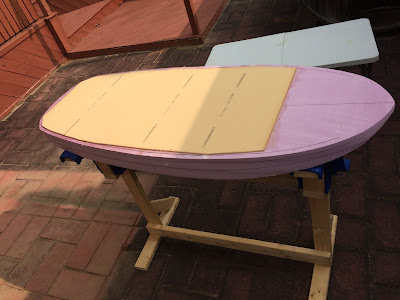No, this is not a political post - it's a post about the foil jibe. Let me start with a video from some beautiful foil 360s:
The video led to a discussion on the Seabreeze forum that made me realize I had some misconceptions about the foil jibe.
This goes back more than a year, when ABK's Andy Brandt gave a foil jibe lecture. He said to put the feet near the rail of the board on opposite sides. On a typical foil board like the Wizard 125, that leads to a rather wide stance (you can see the stance nicely in the 360s in the video above).
Originally, my problem with this advice was that I was using a 71 cm slalom board with a narrow tail. But since I got a foil board a few weeks ago that's much wider in the back, I had another problem. It's probably easiest to explain with a video of a jibe crash:
There's a few things going wrong here. The first one is that I don't control the height well, and the board touches down. The second thing is that the board keeps banking more and more, eventually throwing me off to the inside. That's a pretty typical crash in my jibe tries. I would not mind touching down in the jibe, but have always been puzzled by the board throwing me off to the inside. That just does not happen when windsurfing!
I have been working on planing out of windsurfing jibes for a few decades. It was not until my first ABK camp in Bonaire that I reached a decent success rate, at least in good conditions. One of the things I remember very well from many earlier tries is that you never want to get pressure on the outside rail in a jibe. If you do, the board will immediately turn back, and a crash is virtually guaranteed. I must have verified that thousands of times.
Once I started foiling, I noticed that the foil turns a lot better than my windsurfing boards. So the logical thinking was that any pressure on the outside rail in a foil jibe would be a lot worse than when windsurfing. Maybe comparable to a carve 360 on the windsurfer, which will invariably fail if you flatten the board out at any point? So I tried to move my feet a bit to make this less likely - the front foot more towards the center, and the back foot not quite that far. If you look at my foot positions at the entry, you'll notice that they are quite similar to where they'd be going for a carve 360 on a freestyle board: front foot toes and back foot heel are both on the center line.
Of course, I should have just done what Andy Brandt said, and put my feet to the outsides. But my thinking was that I also need to shift some weight onto the front foot to keep the nose down - and with the foot on the outside rail, that would certainly make the board turn back! I even tried to hang down on the boom to make to push the nose towards the water. That works, but only until you flip the sail, when it's (almost?) impossible to keep mast foot pressure. So as soon as I flipped the sail, the sudden reduction in mast foot pressure would make the nose come up, typically leading to overfoiling and crashes.
Now back to the 360 video. After the initial carve, the sail moves to the back, and the upper body moves forward; the head ends up in front of both feet, almost over the mast base. This means that there must be quite a bit of weight on the front leg - at least half of the weight, if not more. But even though the foot is all the way near the outside rail, the board keeps turning very nicely! Clearly, my theory that putting pressure on the front foot on the outside rail must be wrong!
So it's time for a revised theory. The carve for the 360 (or the jibe) starts with a shift of the weight to the inside of the turn: the back leg. But as soon as the board is banked and turning, the weight can (and should) be distributed evenly over both legs. With little or no pressure in the sail, this stance is actually balanced relative to the push of the foil. This means that the turn radius remain constant. When it is time to flip the sail in a jibe, it's easier to maintain balance due to the wide stance and even weight distribution; the same is true for maintaining flight height.
Going back to the second video (my jibe crash), it is easy to see how changes in the foot positions could have helped. With the front foot closer to the outside rail, it would have been easier to keep the board at a constant angle. In addition, both feet should have pointed more to the front, which would have made it easier to stay balanced when the board touched the water and slowed down.
The funny thing is that I've seen how problematic "thinking" can be in many sports, all the way back to volleyball and judo in high school. I usually did fine when I just copied others or followed instructions, but as soon as I started reading books to "better understand" what I was doing, things started falling apart. The same thing happened over and over in many different sports, including windsurfing. But I just can't help coming up with theories :-). Can't wait to test the newest one on the water!













